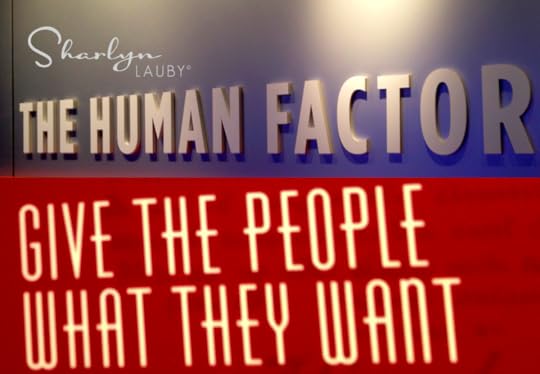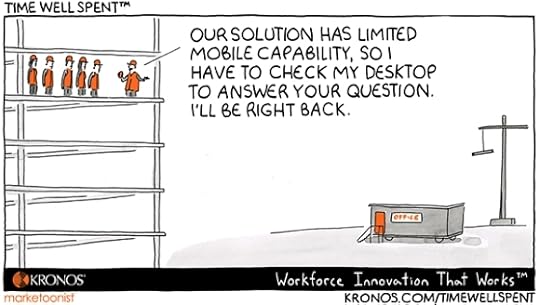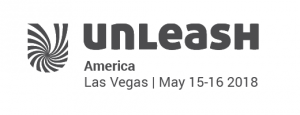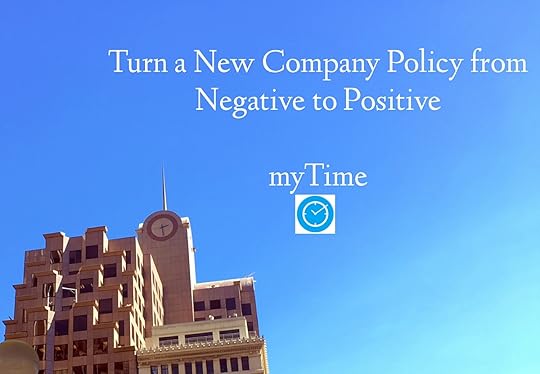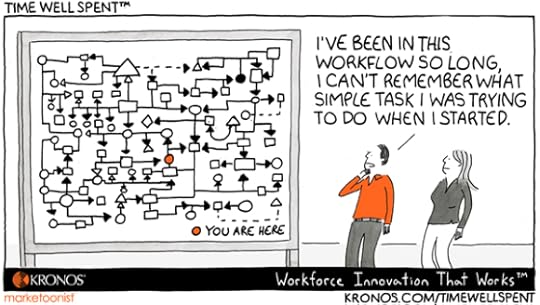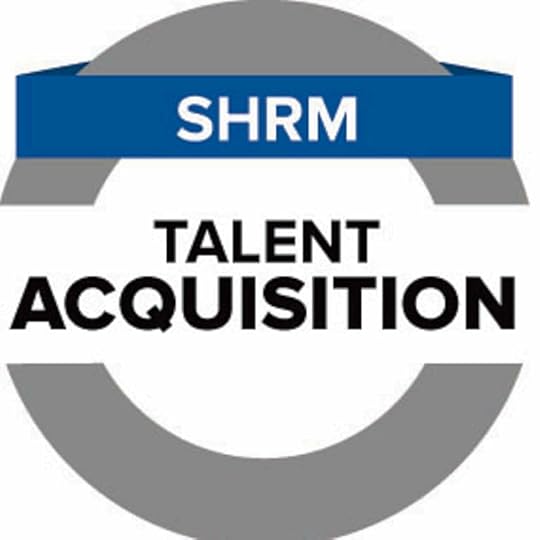Sharlyn J. Lauby's Blog, page 118
May 10, 2018
Recruit Better: Create an Online Realistic Job Preview
“Tell me one of your weaknesses.” is a classic interview question. Of course, no candidate wants to answer with a weakness, so they often come up with a weakness that can also be considered a strength. Like “Oh, I work too much.” Or “I have perfectionist tendencies.”
The same holds true for companies. During the interview process, no organization wants to show off their weaknesses. Like “The CEO is a bit eccentric.” But today’s candidates want a realistic job preview in the organization they’re applying to. Maybe they’re okay with an eccentric CEO.
That goes double for the job they are interviewing for – they want the good, bad, and ugly. Just like companies want to learn the strengths and weaknesses of a candidate.
A realistic job preview is an opportunity in the recruiting process to give candidates a sense of what it’s like to work at the company. They are not only designed for the company to see how the candidate handles certain situations but for the candidate to understand what working conditions are like. An example of a realistic job preview activity is the inbox or in-tray exercise.
With technology, companies are doing some innovative things to provide a realistic job preview to candidates:
Photos and video tours of the office environment
Video of internal meetings (here’s an example from Google)
Testimonials from current employees
Social media sharing (via Facebook pages, Tweets, LinkedIn company pages and Instagram)
Consumers today are doing research prior to making a purchase. Obviously, there are many ways that finding a job is of much greater importance than a purchase. It makes no sense to spend 5 hours reading comparisons between the iPhone X and the rumored Samsung Galaxy S10 to then spend 30 minutes checking out your next future place of employment.
Smart companies are looking for ways to share the employment experience before a person ever decides to apply. And it doesn’t mean sugarcoating the work. Finding a candidate that embraces the company (warts and all) is key to creating engagement.
P.S. Speaking of hiring employees, I’d love to see you at one of the upcoming seminars I’m facilitating for the Society for Human Resource seminar on “Talent Acquisition: Creating Your Organization’s Strategy”. Seminars are available in person and virtually. And they’re approved for recertification credits. If investing in your talent acquisition process is part of the company’s goals this year, you might want to consider checking it out.
The post Recruit Better: Create an Online Realistic Job Preview appeared first on hr bartender.






May 8, 2018
Ethics: Taking Credit For Someone Else’s Ideas – Ask #HR Bartender
Many of us can relate to today’s reader note about ethics. What do you do when you discover that someone has stolen one of your ideas and made it their own?
Can you write a blog post on intellectual integrity and ethics? I recently became aware of a situation where a senior leader in a position of trust overheard and borrowed someone’s idea and passed it off as their own. The leader also rushed to get it out before the other person could say anything.
What type of person does this? Is this becoming more common? How should the person who created the concept respond? I believe it’s reprehensible and primarily speaks to the flawed unethical character of the senior leader.
I don’t want to take anything away from this reader’s note. We all realize that there might be pieces of the story we just don’t have. But this note is a great reminder about ethics and the need for us to demonstrate ethical behavior in the workplace.
Defining Workplace Ethics
Ethics is defined as the “moral principles that govern a person’s behavior or the conducting of an activity”. Ethical behavior is a part of the Society for Human Resource Management (SHRM) competency model. Many other professional organizations include professional ethics in their code of conduct. I think it’s safe to say that, in the workplace, others expect us to act ethically.
If you look at the ethics statements of several professional organizations, you’ll find that there are common themes to ethical behavior in terms of being truthful and not having any conflicts of interest. But there are also differences. Which makes me wonder (or assume) that ethics can vary from organization to organization. And, that they can also evolve over time.
It’s also possible that organizations might choose to have ethical guidelines that are stricter than industry or societal norms. An example would be accepting gifts. In some organizations, accepting any kind of gift, regardless of price, is considered inappropriate (or unethical). Other organizations set an amount of $25 or $50. Other organizations are fine with a different dollar amount. None of them are ‘right’ or ‘wrong’. It’s the ethical standard that the company has set.
Ethical behavior has a direct connection to credibility. If individuals adhere to the ethical standard, they are viewed as being credible in the organization. That being said, I can see situations where someone is following the ethical standard and maybe the tone of their messaging is particularly abrasive. We have to be careful not to label that person as being unethical when the reality is that they’re just being a jerk.
Creating an Ethical Company Culture
Organizations that place a value on ethics can do several things to create and maintain an ethical culture.
Create an ethics statement. Think about the ethical behavior that you expect of others and craft some sort of statement that tells people who do business with your organization what they can expect. The statement can be posted on your company website for candidates, customers, and employees to see.
Include ethics in employee communications. If your employee handbook doesn’t include ethics, it probably should. Talk about ethics in new hire orientation and onboarding. Ethics shouldn’t just be an “HR thing”, it should be a company value. Make sure that managers are comfortable talking about ethical behavior as well.
Record senior management talking about ethics. Speaking of employee communications, look for an opportunity to shoot short videos of senior management speaking about ethics. The videos don’t need to be high-production quality, in fact, it might be better if they look / feel more casual. Ethics should be viewed as something that is discussed regularly.
Ask employees about ethics. Consider adding a question to your regular pulse surveys or annual employee engagement surveys about ethics. Make it a benchmarking question so the organization can notice trends over time. Do employees regularly rate the company as being ethical? Or does the company see their scores heading up/down?
Hold everyone accountable.It’s great to have the first four things but they will be in jeopardy if employees aren’t held accountability. And accountability needs to happen at every level in the organization. Talking about ethics is important – but it alone is not enough.
How to Respond to Unethical Behavior
So, what should an employee do if they feel their ideas have been stolen by someone else? Well, I believe the employee needs to ask themselves a few questions, starting with “Is this worth it?” And what I mean by that, is the idea worth confronting someone over? I’ve had my ideas taken and know the sting that it creates. But many of the ideas weren’t worth getting upset about.
And in the situations where having the idea being labeled as mine was important, I would have a second decision to make. Should I speak with my manager or human resources? Or have a conversation with the person. If it were a serious matter, I’d take it to HR or my manager. A less serious situation, I would speak with the person directly. I would tell them that having a good working relationship was important to me and ask what happened. Sometimes the individual had a perfectly logical response. Sometimes they didn’t.
Which leads to the last point…
If you find out that a person has taken credit for one of your ideas, the company isn’t willing to help, AND the person can’t explain why, THEN you’ve got to decide if you want to work for a manager or a company that you feel has done something unethical. Honestly, I can’t answer that question for you. It’s a very emotional and difficult decision. Especially if you really enjoy the work you do, your compensation and benefits, and like the other people you work with (who act in an ethical fashion).
Have you ever had someone take credit for your ideas? What did you do? Leave us a note in the comments.
The post Ethics: Taking Credit For Someone Else’s Ideas – Ask #HR Bartender appeared first on hr bartender.






May 6, 2018
Candidate Experience: It Includes Job Interviews
You guys know that we’re experiencing a candidate-driven job market. This means that the conversations we’ve been having about employment branding, realistic job previews, and the candidate experience are significant to our future recruitment efforts.
As much as we might be tempted to label the term “candidate experience” a buzzword, we have to resist the urge. The candidate experience is important. But it’s made up of many touch points: from the moment a person learns about the organization to their rejection or arrival on their first day of work. One touchpoint that is sometimes missed is the job interview.
Many pieces of the hiring process – like background checks, applications, etc. – are maintained by human resources. Multiple people from multiple departments get involved in the interview process. It’s essential that everyone who is a part of the interview process understands their role in the candidate experience.
I was having lunch with a friend recently who was sharing her job search stories. We’re both in HR, so we know how these processes are supposed to work. She shared her amazement at the organizations that have forgotten the value in the small details.
So I thought it might be a good time to share a refresher about job interviews. Even when we’ve been doing something for a long time, we forget the details and need someone to remind us, “Yeah, that’s important. I used to do that. I need to get it back in my routine.” If you haven’t audited your interview process lately, here are seven things you might want to review:
Have an application process that’s easy to use. By now, you know that mobile-friendly websites are being given preference in internet search. If your career site isn’t mobile-friendly, well it’s time. Candidates are finding and applying for job opportunities using their mobile devices. And they are sharing great opportunities with their friends using social media on their mobile devices. If your career site isn’t mobile-friendly, then you’re missing out.
Define the purpose of the initial screening interview. Organizations have access to technology tools to help them screen candidates, which is terrific, and they should be fully utilized. The question is what is the purpose of the initial screening interview? Is it to identify culture fit or confirm basic qualifications? I don’t believe this question should be answered solely by the human resources department. HR should work with hiring managers to determine the best definition.
Make candidates feel welcome. When scheduling the screening interview, give candidates a sense of what to expect. For instance, if you’re using video technology for initial screening, let candidates know how to test their equipment, what to do if they have technical challenges, and a what to do if things just don’t work. Good interviews are about conversations. Not about worrying that the technology won’t cooperate.
Create a good first impression. When it comes time to schedule the in-person interview, tell candidates what to expect. Share the small stuff. We always told candidates when they were interviewing on “jeans day” that they were welcome to wear jeans too. We didn’t want them to be surprised and feel uncomfortable. The way candidates are treated the first time they come to your facility speaks volumes about the way they will be treated as an employee.
Choose the right interview format. I’m a big fan of collaborative hiring. Not because managers can’t make decisions, but because the candidate gets to speak with multiple employees during the hiring process. Then when they start, they know more people than the HR director and their manager. In fact, we told people our philosophy during the hiring process. Every company has to choose the right interview format and process.
Tell candidates what to expect after the interview. If a candidate doesn’t ask the question, make sure they know when a final decision will be made, the best person to follow-up with, and how to stay in touch. Candidates don’t want to pester companies. Organizations don’t want to be pestered. The best way to avoid it all together is by setting the expectation at the end of the interview.
Give the process closure. Once a final decision is made, let all of the candidates know the outcome. Even when they don’t get the job, they respect knowing the outcome. It’s possible the organization will be interested in a previous candidate for a future position. Keep the door open by letting candidates know what’s happening in the process. They’re more likely to consider other opportunities or give referrals because they were treated well in the past.
Always remember that candidates are consumers. They can purchase your product or service. Or they can recommend it to others. The candidate experience has a direct impact on the consumer experience. You never want to lose a candidate and a customer at the same time.
P.S. If investing in your talent acquisition process is part of the company’s goals this year, you might want to consider checking it out a seminar I’m facilitating for the Society for Human Resource Management (SHRM) on “Talent Acquisition: Creating Your Organization’s Strategy” We will be covering every touchpoint in the recruiting process. Seminars are available in person and virtually. And they’re approved for recertification credits.
Image captured by Sharlyn Lauby after speaking at the SHRM Annual Conference in Las Vegas, NV
The post Candidate Experience: It Includes Job Interviews appeared first on hr bartender.






May 4, 2018
Can I Have the Answer Immediately – Friday Distraction
I’m a huge introvert, which means that I need quiet time to recharge. So, I’ve been known to ask questions like, “Do I need to make that decision right away?” or “Can I sleep on that?”. These are ways for me (the introvert) to find time to process information. It doesn’t mean that the answer would be negative. It just means I need time to think.
Another comment that people might make to buy themselves some thinking time is “Let me check my calendar and get back to you.” Today’s Time Well Spent from our friends at Kronos made me smile. Is that guy several floors up on the construction site an introvert like me?
Or is that guy lost because he doesn’t have the benefit of technology? It made me wonder. Do we need to be clearer about our intentions?
Ask when decisions need to be made. When I first started consulting, I (mistakenly) assumed that every client wanted a proposal immediately. I was making myself crazy trying to keep up. I finally started asking the question, “When do you want a proposal?” Some clients would answer tomorrow, but the clear majority would say, “Sometime next week is fine.” Don’t make assumptions about when decisions need to be made. Ask the question.
Negotiate your thinking time. Whether you’re an introvert or an extrovert, we are all faced with moments when we want to think over decisions. Again, that doesn’t mean that the questions (or answers) will be negative. Sometimes big career decisions like a promotion, transfer, relocation, etc. warrant some extra time to plan. No one should feel pressured to make a quick decision.
Use technology to help organize information. If that guy in the cartoon really does need to go down to his office to look at some papers on his desk, maybe it’s time to take advantage of what technology brings to the table. Think about those moments when technology can help and find a device or app that can bring your desk to you. You don’t have to do it for everything – I’ll admit that I love my Erin Condren life planner – but I don’t need it for every decision or answer.
It’s not necessary to answer everything right away. Organizations have the opportunity to create cultures that establish decision-making norms – not only how the decision-making process will take place but the time that individuals and teams will be given to get their thoughts together.
The post Can I Have the Answer Immediately – Friday Distraction appeared first on hr bartender.






May 3, 2018
China Gorman on Professional Development in Human Resources
I’m super excited to share today’s interview with you. China Gorman is a friend, colleague, and well-respected business leader. You know her from the leadership roles she’s held with the Society for Human Resource Management (SHRM) and Great Place to Work. I had the opportunity to interview China back in 2009.
But today, China is here to share with us an exciting new professional development event for human resources professionals. The event is called UNLEASH and is being held May 15-16, 2018 in Las Vegas.
China, before we start talking about UNLEASH, let’s talk about professional development in general. Why are conferences a good professional development forum for HR pros?
[Gorman] Well, not every HR pro is interested in the conference experience, and not every HR pro has the budget to attend a national or global conference. But when the interest and budget exist, conferences can be a great way to learn and grow professionally for three reasons.
First of all: content, content, content!
Second: solutions, solutions, solutions!
Third: networking, networking, networking!
Content, more and more, is King and Queen in the live event space. Organizers need to bring diverse, expert speakers to the stage in short bursts.
How does UNLEASH provide participants with the content, solutions, and networking opportunities you’ve mentioned?
 [Gorman] UNLEASH America 2018 is taking place in Las Vegas next month (May 15 – 16, 2018). In our conference format, most of the speakers have between 20 – 30 minutes for their presentations or discussions. This means the attendees can learn from nearly 3 times the number of speakers than at other events!
[Gorman] UNLEASH America 2018 is taking place in Las Vegas next month (May 15 – 16, 2018). In our conference format, most of the speakers have between 20 – 30 minutes for their presentations or discussions. This means the attendees can learn from nearly 3 times the number of speakers than at other events!
Our conference format means that we can attract true thought leaders like Mo Gawdat, Rachel Botsman, and Gary Hamel, along with executive leaders from the some of the world’s most innovative organizations (i.e. Microsoft, GE Digital, Genentech, McKinsey, Cisco, Amazon, etc.). We also have academics and analysts from IDC, Bersin by Deloitte, Bloom & Wallace, etc. More than 100 of the smartest leaders, thinkers, and influencers on our 9 stages over two days.
(Editor’s Note: For your own professional development, you can check out the full speaker line-up on the UNLEASH website.)
Additionally, the UNLEASH Expo is second to none in the live event space. We will provide participants with a curated solutions expo, not open to just any company who can afford the experience. More than 100 exhibitors and sponsors in the larger organization effectiveness ecosystem ready to engage with our attendees, who are senior level decision makers (and not just in HR!) and organization influencers.
Finally, attending live events that cater to your peers is a critical characteristic for networking success. You want to meet your peers, talk with them, and compare notes. You want to be in a more human environment, as opposed to a cattle call environment. You want to meet like-minded leaders with whom you’ll stay in contact long after the event is over. You want an environment conducive to learning, connecting, and discovering new solutions.
Happily, UNLEASH America 2018 provides all of these.
What makes UNLEASH different from all the other HR conferences available?
[Gorman] Good question. UNLEASH’s focus is wider than HR technology. Its premise is that, to unleash the power of an organization’s people, it needs great technology, great leadership, and a focus on the future of work. So, UNLEASH isn’t just an HR technology event. It brings together leaders from the C-Suite of large, medium, and start-up organizations, academic pioneers, and some of the smartest innovators in the people solutions space into one venue for two full days of discussion, engagement, demos, and knowledge sharing.
That sounds like a lot, but this event is truly about bringing organization leaders together with thought leaders and solutions leaders for in-depth discussions on the many stages, at round tables, in the expo, and in the start-up zone. There really isn’t another event like UNLEASH.
How do I sell my boss on attending a conference, especially when it’s in a fun city like Las Vegas?
[Gorman] Sure, Las Vegas is a fun city. But it’s also a hugely affordable conference city. Airfare and hotels tend to be cheaper in Las Vegas than most other locations which is why so many conferences – big, medium, and small – are held there.
Frankly, as a resident of Las Vegas, once you’ve stayed in a couple of casino resorts in Las Vegas, the allure of the slot machines, lights, and table games fade quickly. It’s quite a hospitable and efficient conference town. With the airport literally on the Strip, even taxi, Uber or Lyft fares between baggage claim and the conference hotels are super affordable.
Once you’ve handled the expense side of the equation, then you handle the content features. Just print out the list of speakers at UNLEASH. You’ll be hard pressed to find a more diverse or more senior speaker lineup anywhere in the live event space. This is an investment that will more than pay off.
Last question, If I can’t make UNLEASH, are there other conferences that your organization produces (or webinars, etc.)?
[Gorman] UNLEASH Group produces live events all over the world! The largest of its kind is in Europe in the autumn every year. This fall (October 23-24, 2018) the UNLEASH World Conference & Expo will return to Amsterdam. Earlier this spring it hosted a very successful event in London.
Additionally, it is providing a robust ‘Future of Work’ newsfeed on its website: www.unleashgroup.io. With a robust number of original content pieces edited by Mary Ellen Slayter, and fascinating shared content, our website is becoming the go-to site for news, opinion, survey results and a broad array of content covering the future of work and technology.
I want to send a HUGE thanks to China for sharing a lot of great information about this new professional development opportunity with us. I’m always looking for new events to challenge my thinking and UNLEASH sounds like one that would do just that. I would also be terribly remiss if I didn’t mention that China has her own terrific blog, so if you’re not already subscribed you should check it out.
Sometimes as human resources professionals we’re so focused on everyone’s else’s training and development that we forget our own. Finding time to get away, think, plan, strategize, and learn is key to our success.
The post China Gorman on Professional Development in Human Resources appeared first on hr bartender.






May 1, 2018
How to Turn a New Company Policy from Negative to Positive
(Editor’s Note: Today’s article is brought to you by our friends at Kronos , a leading provider of workforce management and human capital management cloud solutions. For the first time, Kronos was named according to global research and consulting firm Great Place to Work. Congrats to them! Enjoy the article.)
Employees like time off. According to an article in Harvard Business Review, flexible hours and vacations are the two most popular employee benefitsafter health insurance.If organizations want to remain competitive, they need to offer benefits that employees want. You would think that any benefit that gives employees more time off would be met with cheers and adoration.
I recently had the chance to hear about how Kronos rolled out their open time off policy and I thought you would find it interesting. Both from the standpoint of the policy itself but also because of the challenges they experienced and how they addressed them.
You know our friends at Kronos. Tens of thousands of companies use Kronos products, like Workforce Dimensions, including over half of the Fortune 1000. They have 5,400 employees globally, with almost 1,500 in their Massachusetts headquarters. Like many businesses today, Kronos discovered they were facing recruiting challenges. Internal research discovered one of the hurdles to attracting talent was their vacation policy.
So, Kronos wanted to address challenge but in a way that appealed to the greatest number of employees. Their internal research told them that it’s not just Millennials who crave flexibility. For example, the largest users of the company’s student loan repayment benefit are Gen Xers. And older employees want to take time off to attend kids’ events and take care of sick loved ones without “wasting” their vacation days. Employees also wanted time off to volunteer, go on field trips; and general life maintenance.
 In an article for Harvard Business Review, Kronos CEO Aron Ain talked about flexibility being more than a “Millennial” benefit. “We were offering new employees three weeks of paid vacation, which is comparable to what local companies with which we compete for talent were offering. But when our recruiters tried to hire people in their thirties or forties with significant tenure at other companies, they often learned that those people had four or five weeks’ vacation. Vacations are important, and persuading people to take a job with less time off was a challenge.”
In an article for Harvard Business Review, Kronos CEO Aron Ain talked about flexibility being more than a “Millennial” benefit. “We were offering new employees three weeks of paid vacation, which is comparable to what local companies with which we compete for talent were offering. But when our recruiters tried to hire people in their thirties or forties with significant tenure at other companies, they often learned that those people had four or five weeks’ vacation. Vacations are important, and persuading people to take a job with less time off was a challenge.”
myTime: An “Open” Vacation Policy
In response to the company’s recruiting and vacation challenges, HR developed a system called “myTime”. Basically, it’s an “open” (aka unlimited) vacation policy. There’s no limit on how much time any employee can take. Instead employees work their schedules out with their supervisors.
Before we talk about the specifics with Kronos myTime, let’s talk about policies in general. One of the reasons that policies often do not work is because the concept of the policy didn’t take the company’s culture into account. For example, many companies adopt unlimited vacation policies not out of the goodness of their hearts but to save money. We all know that traditional “accrual” vacation policies can be a substantial expense. For large employers, it can add up to $2 – 3 million a year because no more accrued days are banked, so whatever money it formerly paid departing employees goes directly to the bottom-line.
I’ve had the privilege of working with Kronos for years and one of the things I’ve noticed is that they are a company that prides itself on being an organization where family comes first. Even over business. I’ve heard Aron Ain say it many times that family comes first. And Kronites are family. So, it was important to them that this policy reflect their philosophy.“From the beginning, we decided not to try to profit from abandoning a vacation accrual system. We felt it made more sense to reinvest those savings in other employee benefits. So, in addition to offering an open vacation policy, we increased parental leave and added up to $3000 to help offset the cost of adoption. We increased the 401(k) match; created a scholarship program for employees’ children; and launched a child care assistance program. In the end, those new benefits exceeded the savings from changing our vacation policy, but I believe they were worth it.”
Communicate, Communicate, and Communicate Some More
You might think this would be welcomed with fanfare. And many employees were thrilled with the change. However, there was an incredibly vocal minority who were unhappy. And even though they were a minority, let’s face it, sometimes a very vocal minority can have a negative impact on company culture and morale.
In addition, some managers were unhappy because they felt this new policy would make their jobs harder. They were concerned that employees would take advantage of the policy.
And, there was a group of long-tenured employees were unhappy because they felt their length of service entitled them to get more vacation than new employees. Other employees were unhappy because they didn’t value the new benefits like parental leave, scholarship programs, and child care. They viewed their vacation accrual as a sort of savings account.
To help employees work through this major change, Kronos focused on communication. Managers received training and coaching on strategies for handling conflicting scheduling requests. Kronos conducted several town hall style meetings and Ain met with employees individually. “I learned a long time ago that people are entitled to their feelings. It’s never my job to tell them how they should or shouldn’t feel. When talking with people I sympathized, and in some cases I gently pushed back on their logic. A few people were so upset that they talked about quitting, but in the end, I don’t think anyone really left Kronos over the policy change.”
myTime Results: Better Engagement, Higher Profits
The myTime program has been in place since 2016 and Kronos has been tracking the numbers. In the first year that the program was launched, Kronites took off an average of 2.6 days morethan under the traditional accrued PTO policy. Yes, that’s right. Just less than three days more off.
In addition to tracking vacation, they also tracked employee engagement. Since myTime was implemented, engagement scores increased from 84 to 87 percent. Turnover dropped from 6.4 to 5.6 percent. And just in case you’re wondering, Kronos says it’s still very important to track and report time off even though it’s ‘unlimited’ so teams have enough coverage and so HR and people managers can ensure employees are taking enough time off to rewind and refuel. The focus of the program is people.
Kronos shared with me a comment from an anonymous source on Glassdoor who said, “With its unlimited vacation policy, Kronos has upped their game when it comes to benefits.” And now instead of managers saying, “No can do” to vacation requests, they’re now asking employees, “Why aren’t you taking more time off?”
Oh, and let me leave you with just one more result (just in case you’re wondering). Last year, Kronos revenues were $1.3 billion (up $390 million from the year prior). It is possible to create policies that are a win for employees and the bottom-line. Even when things don’t start off as planned.
The post How to Turn a New Company Policy from Negative to Positive appeared first on hr bartender.






April 29, 2018
Should Your Organization Hire Employees for Cultural Fit
Many organizations say that, when it’s time to hire an employee, skills and experience are important but cultural fit matters more. So, what exactly does that mean? Let’s start with what it doesn’t mean. Cultural “fit” isn’t supposed to be similar-to-me. Company cultures can thrive with individuals who are different and still “fit”.
Over time, I’ve come to realize that cultural fit is when a candidate is able to get stuff done within the organizational culture. I’ve worked with individuals who were able to get things done, but they alienated people all along the way. That’s not cultural fit. I’ve also worked with people that were well-liked by their colleagues but couldn’t deliver results. That’s also not cultural fit.
The concept of cultural fit is important. Organizations want to know that an employee’s beliefs and values match with the company, so they will be able to engage, collaborate, provide feedback, and even disagree in the proper context. When I think back on my own career, I found as I moved up the corporate ladder, my job interviews were less about “Can you interview? or Do you know how to conduct training?” and more to determine if I “fit” with the senior management team and the organizational culture.
The culture fit conversation should take place during the interview. The real question is, can organizations create ways to determine cultural fit prior to the interview? This would allow job seekers to see the company culture and decide if they are a good “fit”before applying. The answer is yes, we can.
Start with the company’s mission, vision and values (MVV). Specifically, an authentic mission, vision and values. Not one that looks good on the conference room wall and business cards but doesn’t really mean anything on a daily basis.
Use the MVV to create your organizational culture. Company values should be apparent in the actual way the business runs. How meetings are held, decisions are made, and problems are solved.
Let culture drives your employment brand strategy. The company has a consumer brand strategy. It also needs an employment strategy. What does the organization want candidates to think about them as an employer?
Align brand strategy with the candidate experience. This is where the results of the company’s employment brand are felt – in the candidate experience. The brand strategy is what the organization is selling; the candidate experience is what people think their buying. They need to match.
This results in achieving cultural “fit” – job seekers can peek behind the curtain and see the company. They get a realistic job preview. They decide if they are a good fit before they apply. It positions the company to ask a candidate, “Tell me why you feel you’re a good fit for our organization.” If the company has effectively done their part in sharing an authentic view of the workplace, then candidates should be able to answer the question.
Should you hire for cultural fit? Does everyone even know what that means?Click To Tweet
So for any organization that values cultural fit (and really, who doesn’t?), it’s in everyone’s best interest to build a great corporate culture, employment brand strategy, and candidate experience. I know . . . that’s much easier said than done. Because all of these components are unique to your organization. But you can draw on the creativity, best practices, and lessons learned of others.
P.S. I’m facilitating A Society for Human Resource seminar on “Talent Acquisition: Creating Your Organization’s Strategy” that covers every touchpoint in the process. Seminars are available in person and virtually. And they’re approved for recertification credits. If investing in your talent acquisition process is part of the company’s goals this year, you might want to consider checking it out. I’d love to see you there!
Image of Sharlyn Lauby captured after her SHRM Annual Conference presentation in Orlando, FL
The post Should Your Organization Hire Employees for Cultural Fit appeared first on hr bartender.






April 27, 2018
Workflows Should Be Logical – Friday Distraction
(Editor’s Note: Today’s article is brought to you by our friends at Kronos , a leading provider of workforce management and human capital management cloud solutions. Check out this podcast from The Workforce Institute at Kronos on how Millennial managers are changing the workforce . Enjoy the post!)
Last week, I shared a Time Well Spent from our friends at Kronos that focused on creating systems or processes that employees can use. One of the things that mentioned was that processes should be beneficial (versus cumbersome) even if they involve a few extra steps.
I feel like after seeing this Time Well Spent that I should clarify that a bit more. I’m sure you understand why. Processes and workflows should not be so lengthy that people forget what they’re doing or why their doing it. There should be some level of logic behind a process or system.
Ask stakeholders for their input. When it comes to creating and updating processes, seek feedback from the individuals using the system. The individuals who use the process everyday will have a unique perspective that the company wants to hear.
Be open to hearing another person’s logic. Just because something sounds logical to me doesn’t mean it will be logical to everyone. It’s important for organizations to be receptive to hearing employees explaining what seems logical. It’s also important – especially when talking about processes – to listen to what customer’s think is logical.
Train employees not only on the process but the why. Companies regularly share with employees the steps they need to do in a process. But make sure that the conversation also includes the reason that the step is necessary. Even if the answer is “the government requires us to do this…” Employees need to know “the why” to understand the logic.
Think like a computer program. Whenever I’m trying to put together a logical process that I believe everyone will find intuitive to use, I try to think like a computer. If I had to program a computer to do the steps, what would the steps look like? What’s the minimum number of steps necessary?
Businesses use systems and processes to make workflows easy. And by easy, I mean easy to remember and use. If employees forget workflows, there’s a risk that they will discard them. That’s not good for the company or the customer.
The post Workflows Should Be Logical – Friday Distraction appeared first on hr bartender.






April 26, 2018
How to Design Your Company’s Flexible Workspace Plan
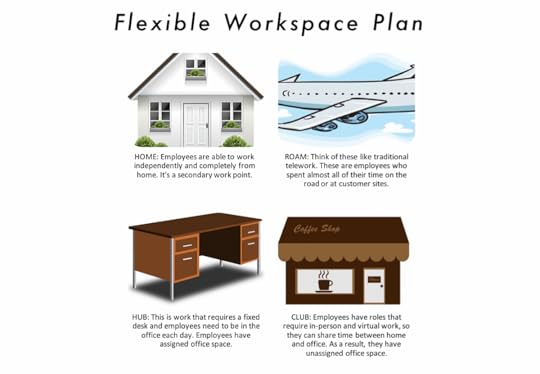 I don’t believe there’s any doubt – employees want flexible work, if they can get it. Granted, not every job is able to have flexibility. For example, the barista at your local coffeehouse isn’t going to be able to work from home. But there are many positions that can and do work outside of a traditional office environment. The question for human resources professionals is, “What’s the best workspace setup?”
I don’t believe there’s any doubt – employees want flexible work, if they can get it. Granted, not every job is able to have flexibility. For example, the barista at your local coffeehouse isn’t going to be able to work from home. But there are many positions that can and do work outside of a traditional office environment. The question for human resources professionals is, “What’s the best workspace setup?”
The reason I raise that question is because I wonder if we haven’t been focused on how broad the flexible workspace opportunity really is. Meaning it’s not a two-option decision of either work in the office or at home. There are other options. And, can we have a flexible workspace plan that allows employees the best of allworlds?
I’ve heard a couple of times recently about American Express’ BlueWork program, which helps the company and employees figure out the best workspace plan to get things done. The plan offers four options: home, roam, club, and hub. Check out the image for a brief description of each.
I really like the way this plan is designed because the company can create a workspace plan based on the needs of each category. For example, HOME employees have different needs in terms of support than ROAM employees. In addition, ROAM employees have different technology needs than HUB employees. It seems to me for each of these plans, companies should determine workflows in several areas.
Ergonomics: Employees need to have workspaces. That might be at home, in the office, or on the road. In some cases, the company is going to supply the workspace. And in other cases, the company needs to give employees good guidance on how to work effectively from a remote location.
Technology: I’d like to think we all realize that technology and work go together. But what kind of technology – desktop, laptop, tablet, or maybe BYOD? Then there’s software. Each different worker needs the best tech for their role. And they need to know how to use it.
Support: This is probably a good time to talk about support. I don’t mean managers (I’m saving that one for last.). I’m referring to HR, payroll, accounting, IT, purchasing, etc. These departments support the rest of the organization. They need to have policies/procedures/guidelines that allow each type of worker do get things done.
Management: Last but certainly not least, managers need to know how to work with each type of employee. This includes communication, goal setting, performance conversations, etc. Just because an employee isn’t in the office, doesn’t mean they don’t deserve management’s attention and support.
Organizations can evaluate jobs and survey employees on the needs of their position to determine the best option for their flexible workspace. I can also see where there might be times when an employee takes on a special project and their role must be re-evaluated. (as in, “I was CLUB but now that I’m on the CEOs pet project, I need to be HUB.”).
Flexible work is more nuanced than we might think. But there are opportunities to bring it some structure. It takes working with employees to understand the job requirements.
The post How to Design Your Company’s Flexible Workspace Plan appeared first on hr bartender.






April 24, 2018
3 Reasons to Earn the SHRM Talent Acquisition Specialty Credential
Just in case you missed it, during the Society for Human Resource Management (SHRM) Talent Conference, they announced a new specialty credential in talent acquisition that will launch in June 2018.
If you’re wondering what a specialty credential is, think of it as sort of a micro credential. It demonstrates your knowledge and skills specifically in talent acquisition. You do not need to be SHRM-SCP or SHRM-CP to pursue this credential. So, why study for it? Here are three reasons:
For yourself. There are many HR-related credentials out there. This one is focused on talent acquisition. For individuals who are solely dedicated to recruiting and talent acquisition, this gives you the opportunity to demonstrate your knowledge and abilities. Pursuing a credential can make you stand out when it comes to new career opportunities both inside and outside your organization. Even if you don’t spend 100 percent of your time on talent acquisition, it could make sense for you to get the specialty credential.
For your organization. Sourcing, engaging, and retaining talent are top priorities for organizations. Senior management will want to know that the people creating and leading their talent strategy know their stuff. Having a credential can indicate to your boss and company that you’re knowledgeable and decided to the talent acquisition profession. And if you’re a generalist, it can allow the organization to see that you’re committed to the strategies surrounding talent.
For your candidates. Talent acquisition professionals spend tremendous time and energy building relationships with candidates. For the jobs they have today and the ones they will have tomorrow. Being able to share with candidates that you’re a dedicated talent acquisition professional can make you and your organization stand out in the candidate’s mind. Think employment brand. Candidates know they’re dealing with professionals and, as a result, the candidate experience will be top notch.
To earn the credential, individuals must enroll in SHRM’s Talent Acquisition: Creating Your Organization’s Strategy seminar (available in-person or online); participate in six comprehensive SHRM eLearning courses on talent acquisition-specific topics including recruiting, analytics and hiring trends; and pass an online 50-question knowledge exam.
The organizational focus on talent acquisition isn’t going away anytime soon. The numbers tell us that. With Boomers planning their exit strategies and fewer Millennials coming into the workforce, companies need to think about how they will find the best talent. And they will be looking for the best people to do it.
P.S. If you’re thinking about putting together a study plan for this new specialty credential, a resource that might help you is “A Manager’s Guide to Developing Competencies in HR Staff: Tips and Tools for Improving Proficiency in Your Reports” by Phyllis Hartman. This book offers practical tools in terms of checklists and spreadsheets that you can use for self-learning or guiding your team. I could see a book like this becoming a roadmap for earning the specialty credential along with the SHRM seminars and eLearning courses.
The post 3 Reasons to Earn the SHRM Talent Acquisition Specialty Credential appeared first on hr bartender.






Sharlyn J. Lauby's Blog
- Sharlyn J. Lauby's profile
- 10 followers




